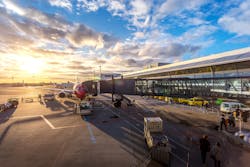Reimagining Ramp Operations: How AI is Transforming the Turnaround
For decades, ramp operations have been treated as routine logistics: a cycle of fueling, catering, baggage handling, and pushback. These activities, while essential, have long operated behind the scenes with minimal oversight, supported by fragmented coordination and manual communication.
As passenger volumes continue to grow and physical expansion remains limited at many airports, the ramp is increasingly recognized as a critical point of operational performance, and one of the most promising areas for technological innovation.
At the heart of ramp operations is the turnaround process – the critical window between an aircraft’s arrival and its next departure. Every minute here matters. A delay on the stand can ripple across the network, affecting aircraft rotations, gate availability, and passenger connections. Similarly, every minute of unnecessary Auxiliary Power Unit (APU) use adds fuel burn, costs, and emissions.
Executing a seamless turnaround isn’t just about speed, it’s about coordination, safety, and environmental responsibility. As the stakes get higher, traditional tools are no longer viable for managing these factors effectively. As a result, airports and airlines are increasingly turning to digital tools to optimize the ramp’s strategic value.
Creating smarter, more collaborative ramp operations
Ramp operations bring together many moving parts; from ground handlers, fueling teams and catering services to airline operators and airport staff – all working on tight timelines and often relying on manual processes or siloed systems. Historically, this made coordination difficult and collaboration reactive rather than proactive.
AI-powered ramp technology is changing that. Using computer vision and machine learning to monitor and analyze events such as jet bridge movement, fueling, baggage loading, and Ground Power Unit (GPU) connection, AI systems provide a real-time, objective view of each turnaround.
This shared visibility transforms how teams work. When everyone operates from the same data, coordination improves, issues are flagged earlier, and recovery from disruption becomes faster and more collaborative.
At major hubs such as Seattle-Tacoma, Toronto Pearson, and London Heathrow, this kind of visibility is already delivering measurable value. Seattle-Tacoma reported a 17% increase in on-time performance for flights managed by AI software, Toronto Pearson saw a 44% reduction of taxi in time, and London Heathrow is estimated to receive an additional $121 million in revenue through better gate utilization. These improvements demonstrate how minor changes across thousands of daily movements can translate into significant gains in efficiency, capacity, and cost control.
Technology doesn’t replace frontline expertise, it enhances it. Automation handles repetitive monitoring and reporting tasks, allowing experienced personnel to focus on problem-solving, safety, and execution. The result is smarter, more connected, and more resilient ramp.
Safety through AI-generated alerts
Ramp safety is another area where AI is proving valuable. The ramp is a complex environment, with multiple teams and heavy equipment operating near aircraft. Maintaining situational awareness across dozens of gates and stands simultaneously can strain even the most experienced teams.
Computer vision improves this by continuously monitoring stand activity and identifying potential safety risks in real time, such as early pushback without clearance or ground support equipment left in unsafe positions.
When an issue is detected, the system generates an alert, giving ramp supervisors the opportunity to intervene before an incident occurs. This proactive approach supports day-to-day safety as well as long-term compliance with Safety Management Systems (SMS). It also creates a verifiable digital record of events, which is increasingly important for audits, investigations, and insurance processes.
As airports become more complex, AI-powered safety systems offer a critical layer of oversight, without adding to team workload.
Lowering emissions with smarter ramp operations
Sustainability discussions in aviation often center on aircraft and fuel, but emissions on the ground are equally important, and more immediately addressable. A key opportunity is reducing unnecessary APU usage at the gate.
Minimizing APU run time is one of the most actionable ways to lower emissions for both airlines and airports, but doing so requires accurate, real-time insight into the turnaround, specifically, knowing when external systems like GPU and pre-conditioned air (PCA) are connected and ready to use.
AI-powered ramp monitoring enables this level of visibility. By tracking GPU and PCA connection times and comparing them to APU usage, the system highlights inefficiencies and identifies procedural gaps.
These insights allow operations teams to retrain where needed, refine procedures, and continuously improve performance.
At Toronto-Pearson Airport, for example, the 44% reduction in average taxi-in time, resulted in savings of 120 million kilograms of CO2 emissions. These incremental improvements, scaled across hundreds of daily movements, contribute directly to Scope 1 and Scope 3 emissions targets, helping airports and airlines meet sustainability goals while also improving operational efficiency.
Building long-term resilience through digital transformation
Ramp operations are no longer a behind-the-scenes function. They sit at the intersection of passenger experience, airline performance, infrastructure capacity, and sustainability. In an operational environment defined by rising demand, staffing challenges, and environmental pressure, the need for transformation is clear.
Leading airports and airlines are already investing in AI-powered turnaround solutions to build long-term resilience. These systems are not just streamlining workflows, they’re enabling smarter decisions, faster recovery, and greater agility in the face of disruption.
Looking ahead, AI-powered ramp systems will continue to evolve, with increasing predictive capabilities and deeper integration into airline network operations. These advances will enable more proactive disruption management and even support the safe deployment of autonomous ground service equipment in the future.
By embracing real-time visibility, proactive alerting, and data-driven collaboration, the industry is turning the ramp into a strategic advantage. In today’s environment, every minute, movement, and decision on the ramp matters, and with the right technology, airports and airlines can ensure each one translates into improved performance and efficiency.
This article was written by Tim Toerber, President-Americas, Assaia, a company that develops AI-based software to help airports and airlines monitor and improve aircraft turnaround operations. Its tools provide visibility into the turnaround process, with the goal of enhancing efficiency, safety, and sustainability.
About the Author


